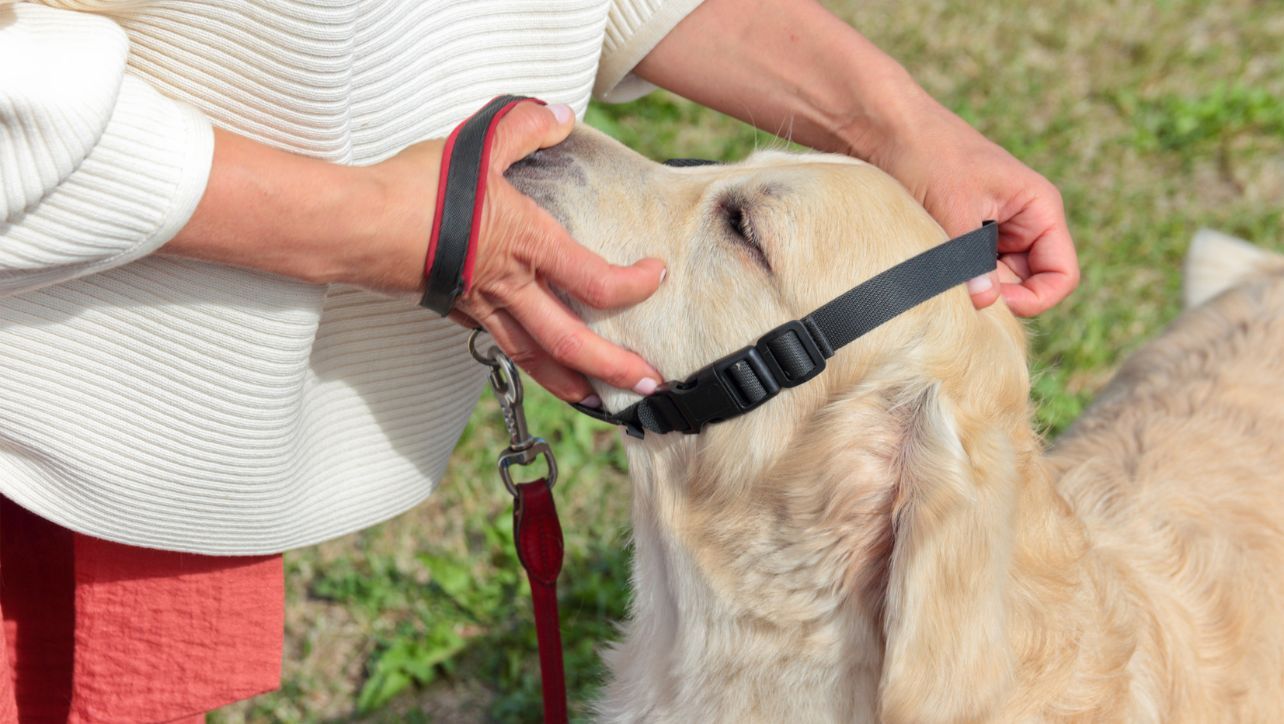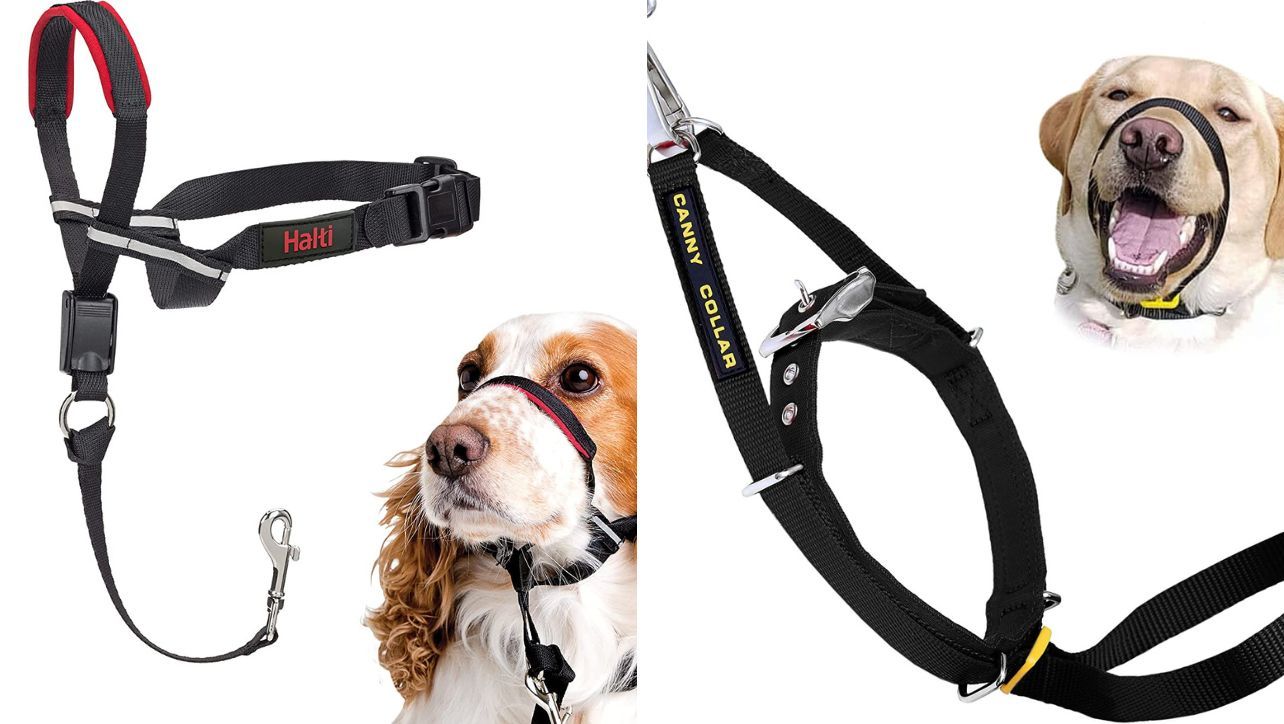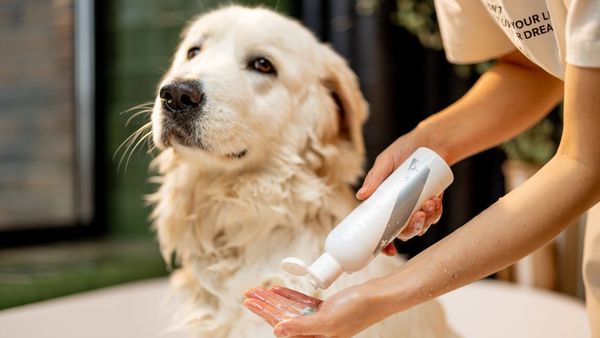A dog head collar or head halter is a type of dog collar that fits around a dog's nose and behind their ears, similar to a halter on a horse. It is designed to provide gentle control and help prevent pulling on the leash.
These collars typically consist of two straps – one that goes around the dog's nose and another that goes behind the ears – connected by a ring that the leash attaches to.
When the dog pulls, the collar gently turns their head, which can discourage pulling and make it easier for the owner to control the dog.
While it can take some dogs time to get used to wearing a head collar, many pet owners find them to be an effective training tool for leash manners and improving overall walking behavior.
What Are Head Collars Used For?
Head collars are used for a variety of reasons, such as to prevent or stop dogs from pulling on their leash, to discourage dogs from jumping, to facilitate training, and for safety purposes during walks.
Some dogs may be more prone to pulling, which can make walks uncomfortable or even dangerous for both the dog and their owner.
Head halters provide a way for owners to gently redirect their dog's attention and discourage unwanted behaviors, promoting better leash manners and improving overall behavior.
Using a head collar correctly can help to create a safer and more enjoyable walking experience for both the dog and their owner.
Is A Head Halter A Muzzle?
No, a head halter is not a muzzle. A muzzle is a device used to prevent a dog from biting, whereas a head halter is simply a type of collar used for training purposes and to encourage good leash behavior.
A head halter is designed to fit snugly around the nose and behind the ears, while still allowing the dog to open its mouth and bark, eat or drink.
While a head halter can help to prevent unwanted behaviors, it does not prevent a dog from biting or eating.
It's important for pet owners to understand the difference between a head collar and a muzzle and use the appropriate device for their dog's needs.
Are Head Collars Good For Dogs?
For some dogs that are prone to pulling or lunging on a leash, a head halter can be an effective tool to help redirect their attention and encourage good behavior. Using a head halter correctly can also help to create a safer and more enjoyable walking experience for both the dog and their owner.
However, it's important to note that some dogs may not be comfortable wearing a head collar, so it's important to introduce it gradually and in a positive manner.
It's also important to use a head halter correctly and to avoid using it as a substitute for training and positive reinforcement.
Ultimately, whether or not a head halter is good for a specific dog depends on their individual needs and behavior, so it's important to consult with a veterinarian or professional dog trainer before deciding to use one.
Do Head Collars Stop Dogs Biting?
While a head halter can help to reduce the risk of dogs biting during walks by discouraging pulling and promoting good behavior, it is important to understand that a head halter is not a muzzle and does not prevent dogs from biting.
If your dog poses a risk of biting people or other animals, it is important to address the underlying behavioral issues through professional training and to use appropriate restraints, such as a muzzle.
It is never recommended to use a head collar or any other type of restraint as a substitute for addressing the root cause of a dog's aggression or biting behavior.
How Do You Walk A Dog With A Head Halter?
If you are planning to walk your dog with a head halter there are a couple of steps you need to follow.
First, ensure that the head halter fits your dog correctly and comfortably. An ill-fitting head halter can make the dog uncomfortable or even cause chafing.
Then, start by introducing your dog to the head collar and allowing them to sniff it and get used to it slowly.
Once your dog is comfortable wearing the head halter, attach the leash and practice walking indoors in a controlled environment before taking your dog outside for a walk.
When walking your dog with a head halter, it is important to hold the leash gently and avoid using force. Let the dog walk at their own pace and avoid yanking or pulling the leash. If the dog starts to pull, gently guide them back towards you by turning the leash and directing their attention towards you.
Avoid sharp or sudden movements, which can startle or confuse your dog.
With consistent training and positive reinforcement, your dog can learn to walk calmly and comfortably with a head halter.
What are the different types of head halters?
There are several types of head halters available for dogs, with varying designs and features. Some of the most common types include:
Traditional Head Collar:
This type of collar typically consists of a nose loop, neck strap, and leash attachment. It provides good control over the dog's movements and can help prevent pulling.
Halti Head Collar:
The Halti is a brand of head halter that has a padded nose band and an additional safety strap that goes behind the dog's head. This design gives you more control over your dog's head movement, making it easier to train them not to pull.
Gentle Leader Head Collar:
The Gentle Leader is another popular brand of head halter that has a similar design to the Halti. It places pressure on the back of the neck instead of the nose, which can be less intimidating for some dogs.
Back-Clip Head Collar:
This type of head halter has a leash attachment at the back of the dog's head instead of the nose. It provides less control than a traditional or Halti-style collar but can be more comfortable for dogs who don't like having pressure on their face.
No-Pull Head Collar:
Some head halters are specifically designed to help prevent pulling. They often have a front leash attachment that encourages the dog to move in the opposite direction when they try to pull.
It's important to choose the right type of head halter for your dog's personality and needs. Consult with a veterinarian or professional dog trainer for guidance on what type of head collar would work best for your pup.
What is a Gentle Leader?
The Gentle Leader is a brand of head collar that is designed to discourage dogs from pulling on their leash. It works by fitting over the dog's nose and attaching to their collar or harness, giving you greater control over their head movement.
When the dog pulls on the leash, the Gentle Leader gently redirects their head toward you, discouraging them from continuing to pull.
The Gentle Leader is considered a humane and effective way to train your dog not to pull on their leash. It does not cause pain or discomfort but simply uses gentle pressure to redirect your dog's attention back to you.
The design of the Gentle Leader also allows you to maintain control over your dog without having to use force or harsh training methods.
It's important to note that the Gentle Leader should be used as a training tool and not worn all the time. It may take some time for your dog to adjust to wearing the head halter, so be patient and consistent with your training.
They offer a collar and video training guide for a reasonable price. Click this link to check it out on Amazon.
Consult with a veterinarian or professional dog trainer for guidance on how to properly fit and use a Gentle Leader with your dog.
Why does my dog pull on the leash?
Many dogs pull on their leash when they are being walked, and there are several reasons why this behavior may occur. Here are some of the most common reasons why dogs pull on their leash:
Excitement:
Dogs may become excited when they are outside and want to explore their surroundings, which can cause them to pull on their leash.
Fear or anxiety:
Dogs that are fearful or anxious may pull on their leash as a way to try and escape from a perceived threat or uncomfortable situation.
Lack of training:
Dogs that have not been properly trained to walk on a leash may pull because they do not understand and haven't been taught how to walk calmly on a leash yet.
Distractions:
Dogs may pull on their leash if they are distracted by other animals, people, or scents in their environment.
Breed tendencies:
Some breeds are more inclined to pull on their leash than others, particularly those that were bred for tasks like hunting or herding.
It's important to address pulling behavior as early as possible to prevent it from becoming a habit. Consistent training, positive reinforcement, and using the right equipment (like a Gentle Leader) can all help reduce pulling behavior. Consult with a veterinarian or professional dog trainer for guidance on how to properly train your dog to walk calmly on a leash.
Is a loose leash essential when walking your dog?
Yes, walking your dog on a loose leash is generally considered to be ideal. A loose leash means that there is some slack in the leash between you and your dog, and your dog is not pulling or tugging on the leash.
Walking your dog on a loose leash has several benefits. It allows your dog to move more freely and comfortably, and it can also reduce the risk of injury to both you and your dog. Walking on a loose leash also helps to establish a stronger bond between you and your dog and promotes better communication during walks.
On the other hand, walking your dog on a tight leash can be uncomfortable and even painful for your dog, causing them to pull harder to try and relieve the pressure. This can lead to a vicious cycle of pulling and discomfort that makes walks stressful and unpleasant for both you and your dog.
Teaching your dog to walk on a loose leash takes time and practice, but it can be achieved through positive reinforcement training and consistency. It's important to reward your dog when they walk calmly on a loose leash and avoid punishing or scolding them when they pull. With patience and training, you and your dog can enjoy peaceful and enjoyable walks together.
Are head collars safe for dogs?
Yes, head halters can be safe for dogs when they are used correctly and fitted properly. Head halters, including brands like the Gentle Leader and Halti, are designed to be humane and effective training tools that can help discourage pulling on the leash.
When using a head halter, it's important to ensure that it fits your dog correctly and is not too tight or too loose. A properly fitted head halter should allow your dog to pant and drink water, but should not be so loose that it slips off or so tight that it causes discomfort or restricts breathing.
It's also important to follow the manufacturer's instructions for fitting and using the head collar. Improper use of a head halter can cause injury or discomfort to your dog, so it's critical to use it in the way it was intended.
If you are unsure about how to properly fit or use a head halter with your dog, consult with a veterinarian or professional dog trainer for guidance. They can help you select the right type of head halter for your dog and provide tips on how to use it safely and effectively.
Can a puppy wear a head collar?
Yes, puppies can wear head halters, but it's important to ensure that the head halter is appropriate for their size and age. Head halters are typically recommended for dogs that are at least 6 months old and have stopped growing, as their size and weight can impact the effectiveness of the collar.
When choosing a head collar for your puppy, be sure to select one that is specifically designed for puppies or small dogs and ensure that it fits your puppy properly. A head collar that is too loose may not work effectively, while a collar that is too tight can cause discomfort and even injury.
It's also important to introduce the head collar to your puppy gradually and with positive reinforcement. Allow your puppy to sniff and explore the head collar before putting it on, and reward them with treats or praise when they wear it calmly.
As with any training tool, it's important to use a head collar responsibly and under the guidance of a professional dog trainer or veterinarian. They can help you select the right type of head collar for your puppy and provide tips on how to use it safely and effectively.
Are head collars cruel?
No head collars are not inherently cruel when they are used correctly and fitted properly. Head collars, including brands like the Gentle Leader and Halti, are designed to be humane and effective training tools that can help discourage pulling on the leash.
Head collars work by fitting over the dog's nose and attaching to their collar or harness, giving you greater control over their head movement. When the dog pulls on the leash, the head collar gently redirects their head towards you, discouraging them from continuing to pull.
When used properly, head collars do not cause pain or discomfort to the dog. Instead, they use gentle pressure to redirect the dog's attention back to the owner.
This is in contrast to choke chains or prong collars, which rely on physical punishment to discourage pulling behavior and are not recommended as training tools.
It's important to always use a head collar as a training tool and not as a permanent solution. With consistent training and positive reinforcement, dogs can learn to walk calmly on a leash without the need for a head collar or other training aid.
If you have concerns about using a head collar or any other training tool with your dog, consult with a veterinarian or professional dog trainer for guidance. They can help you select the right training tool for your dog and provide tips on how to use it safely and effectively.

Fitting and Training For A Dog Head Halter
Fitting a head halter for your dog can take some time and patience, but it is important to ensure that the halter fits comfortably and securely. Here are the recommended steps to properly fit and train your dog to wear a head halter:
Introduce the halter:
Before putting the halter on your dog, let them sniff it and get used to the feeling of it in their mouth and around their head.
Put the halter on:
Place the halter over your dog's nose and neck, making sure that it is not too tight or too loose. The noseband should be snug but not uncomfortable, and the neck strap should be adjusted so that you can fit two fingers between it and your dog's neck.
Attach the leash:
Once the halter is on, attach the leash to the ring on the bottom of the noseband.
Begin training:
Start by walking your dog in a low-distraction environment, praising them when they walk calmly on the leash. When your dog pulls, gently redirect their attention back to you with a slight tug on the leash.
Increase distractions:
As your dog becomes more comfortable with the halter, gradually increase the level of distraction in your training environment. This will help your dog learn to stay calm and focused even in busy or exciting situations.
Use positive reinforcement:
Reward your dog with treats and praise when they walk calmly on the leash, and avoid punishing or scolding them when they pull.
It's important to note that using a head halter should be part of a larger training program that includes positive reinforcement and consistency. Consult with a veterinarian or professional dog trainer for guidance on how to properly fit and train your dog with a head halter.

Halti Head Collar vs. Canny Head Collar
The Halti Head Collar is a popular brand of head collar that has a padded nose band and an additional safety strap that goes behind the dog's head. This design gives you more control over your dog's head movement and can be helpful for training dogs not to pull on the leash.
The Halti Head Collar is available in a range of sizes to fit most dogs, and it is generally considered to be a humane and effective training tool.
The Canny Head Collar is another type of head collar that works on the same principle as the Halti. It features a noseband that fits over the dog's snout and a collar that fastens behind the dog's ears.
The Canny Head Collar is designed to help prevent pulling without causing discomfort or pain to the dog. Unlike the Halti, the Canny Head Collar does not have an additional safety strap, which may make it less secure in some situations.
Ultimately, the choice between the Halti Head Collar and the Canny Head Collar will depend on your dog's individual needs and preferences. Both types of head collars can be effective at reducing pulling on the leash, and it's important to choose a collar that fits your dog properly and is comfortable for them to wear. Consult with a veterinarian or professional dog trainer for guidance on what type of head collar would work best for your dog.
But I can let you know that our dog Dobby prefers the Halti Collar, probably because of the padded nose strap. Click here to check the price on Amazon.
What Are The Cons of Head Collars?
While head collars can be an effective training tool for some dogs, there are also some potential downsides to using them. Here are some of the cons of head collars:
- Need for training: Head collars should be used as a training tool and not relied upon as a permanent solution. They require consistent training and positive reinforcement to be effective, and may not work for all dogs.
- Can be uncomfortable: Some dogs may find head collars uncomfortable or even stressful to wear, particularly if they are not fitted properly or used incorrectly.
- May cause injury: If used improperly, head collars can cause injury or discomfort to dogs, particularly if they are too tight or used for extended periods of time.
- Potential for negative associations: Some dogs may develop negative associations with the head collar, particularly if it is used as a punishment or if the dog is not properly trained to use it.
- Limited control: While head collars provide greater control over a dog's head movement, they may not be as effective at controlling their body movements. This can make it more difficult to prevent jumping, lunging, or other unwanted behaviors.
It's important to consider these potential downsides when deciding whether to use a head collar with your dog. Consult with a veterinarian or professional dog trainer for guidance on what type of training tool would work best for your dog.
Are Head Halters Good for Reactive Dogs?
Head halters can be a useful tool for managing reactive dogs, as they provide greater control over the dog's head movement and can help redirect their attention away from triggers that may cause them to react.
Reactive dogs may exhibit behaviors like barking, growling, or lunging at other dogs, people, or stimuli in their environment
When used properly and under the guidance of a professional dog trainer or veterinarian, head halters can help reduce reactivity and improve a dog's response to training.
Head halters like the Halti or Gentle Leader are designed to discourage pulling on the leash by redirecting the dog's head toward their owner when they pull. This can help prevent reactive dogs from lunging or jumping toward other dogs or people on walks.
It's important to note that head halters should not be relied upon as a permanent solution for reactive behavior. They should be used in conjunction with positive reinforcement training and behavior modification techniques to address the underlying causes of reactivity.
Consult with a professional dog trainer or veterinarian for guidance on how to properly fit and use a head collar.
Do Head Collars Help With Pulling?
Yes, head collars can be effective in reducing or eliminating pulling behavior in dogs.
Head collars work by allowing the handler to redirect the dog's attention and control their movement more easily, without causing pain or discomfort. This makes them a humane alternative to other types of collars, such as choke chains or prong collars, which can cause physical harm to the dog.
However, it's important to note that head collars are just one tool in a larger training program and should be used in conjunction with positive reinforcement techniques and consistent training to achieve the best results.
I hope this article has helped you learn more about head halters and given you the ability to make the best decision for your pup.
And as always, get out there and Love Life!







